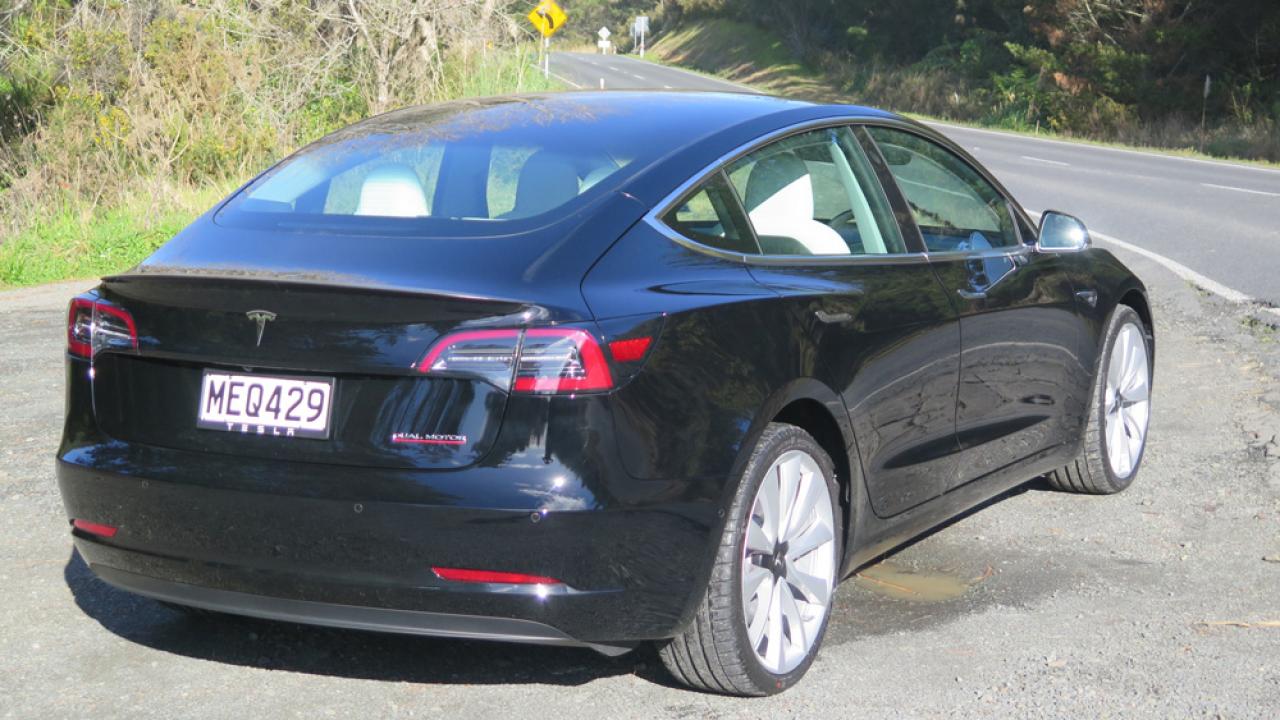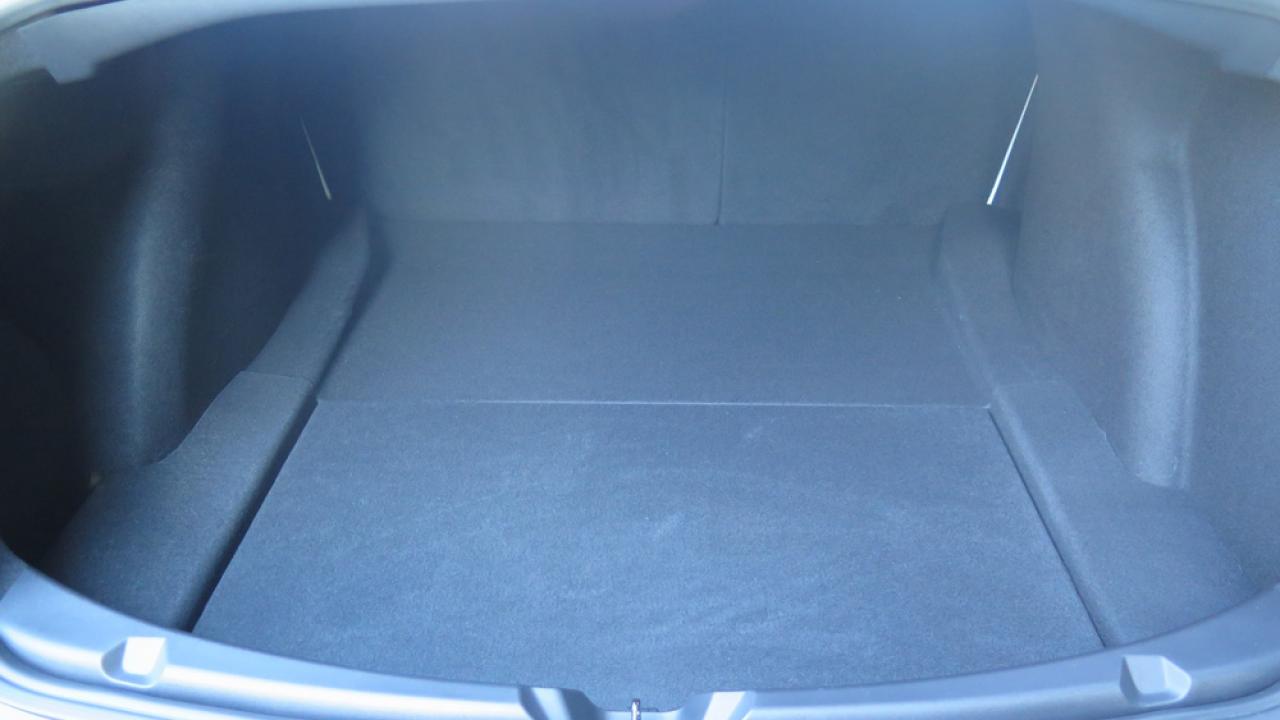Still, that was certainly enough to whet the appetite.
Tesla’s aim was to introduce a more affordable car, while still leaving onlookers no doubt what the brand is, or the ‘fuel’ that drives it. Which meant a few exterior cues to link this vehicle to its pricier S and X siblings – yep, there are now three models of Tesla – such as door handles flush to the body panels. And like the others, this car is billed as fast – and boasting a real-world kilometre range on a full battery.
With the red calipers, the 20-inch wheels and carbon spoiler it certainly looks thrusty, and that’s what you discover when you drive it.
Electric motors deliver shedloads of torque at low speeds – which is why even the most modest of the breed can feel like a greyhound when launching from lights and junctions. But what amazed with this car was its otherworldly thrust at or near the speed limit. Tap the throttle and it’s almost like being on the Starship Enterprise, but with a risk of speeding tickets if you get too throttle-happy. It’s smooth, deceleration is as brisk as acceleration – a quick glance at the menus suggest deceleration force is adjustable – and with good front-to-rear balance, all-wheel drive and a low centre of gravity thanks to siting the batteries under the floor, it could be reasonably agile. Sadly we couldn't confirm that within our limited timeframe, and we eagerly await the promised longer drive on familiar roads.
Tesla’s spokesperson said the brand doesn’t reveal kWh – or indeed any details on how much oomph is produced from that battery, and how it’s translated into motion at all four wheels. It will tell us you can use Tesla’s network of chargers, or your household socket, to recharge it.
But we’ve digressed. Locking and unlocking come via an app downloaded to your phone, or a card more or less identical to a hotel key card. Press your thumb onto the doorhandle for the handle end to pop out, open conventionally, and slide into the spacious cabin. It feels incredibly roomy, thanks partly to the blinding-white upholstery, and the glass roof – it looks pretty dark, but the rear window extends to the B pillar, with tinting demarking where ‘window’ ends and ‘roof’ begins.
Other than that, there’s little to see. A steering wheel, with two mouse ‘wheels’ for controlling functions, a couple of the standard steering wheel stalks (whoever designed the first stalk indicator should take a bow), and a 15-inch central-mounted screen. Yep, no instruments, no knobs and buttons, not even any visible vents, though air is clearly emerging – you control the angle via swipes and pinches on the relevant screen.
We expected to hate it – but flicking your eyes to the middle for speed is barely less tricky than down, and everything seemed easy to find, and use. The Satnav employs Google maps, delivered via that humungous screen so it’s easy to see, the reversing camera is equally large and sharp, and of course there’s handsfree Bluetooth. The only downside of accessing everything via a single touch screen was that it wasn't immediately apparent how to quickly control the temperature, say, or the volume, though to be fair we didn’t really have enough time to check what, if any, shortcuts are available.
Some of the displays on that high-res screen are fabulous. For example, there’s a moving graphic of exactly where nearby traffic is, and whether it’s a car or truck. You can see vehicles catching up, pulling away or nearing, which side of you they’re on – it’s extremely accurate and, we’re told, already like that so when full autonomy is allowed, it’s ready to go.
Otherwise the misleadingly named ‘Autopilot’ is simply an auto cruise control, which maintains distance from the car in front and steers to keep you in lane, as an increasing number of cars already do. That, and all the other safety systems, rely on information from a battery of eight cameras, 12 ultrasonic monitors and a forward facing radar.
The initial feel to this car is not ‘cut price’, unless you object to manually opening the rear, or the relatively simple lining to the surprisingly spacious boots. Yes, plural – there’s the conventional boot, a sizeable cubby beneath it, and another under the bonnet plenty big enough for an overnight bag, and with two fold-out ‘curry hooks’ to hold your shopping or takeaway bags upright.
So that’s it, albeit once over lightly. First impressions are that it’s quick, smart, handsome, high tech and effective.
What’s it pitched against? Given its quirks, it can be hard to tell. Its 4.7-metre length and spacious interior put it somewhere between BMW’s 3 and 5 Series, that interior space largely due to the lack of mechanicals to fit in, assuming that a likely BMW owner wants a full-electric car.
And that competition tells you something – this may be the most affordable Tesla and soon, says the factory, the most numerous one, but certainly in this Premium spec it’s not exactly mass market, at least not yet.
|
At a glance |
|
|
Models |
Tesla Model 3 |
|
Engine |
Dual-Motor Electric |
|
Price |
$104,960 (Drive away price) |
|
ANCAP safety rating |
5 |
|
Power and Torque |
Not supplied |
|
Transmission |
Auto |
|
Fuel economy |
460km range on a full battery |
|
Towing capacity |
Not rated for towing |
|
2WD/4WD/AWD |
AWD |
|
Seating capacity |
5 |
|
Luggage capacity/payload |
542 litres (inc front/rear boots) |
Safety systems
- Auto Emergency Braking
- Lane Keep Assist
- Lane Departure Warning
- Blind Spot Monitor
- Forward Collision Warning
- Rear camera
- Speed Sign Recognition
- Auto High Beam Headlight







